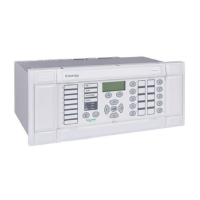P54x/EN CM/La4 Commissioning
(CM) 10-48
MiCOM P543, P544, P545 & P546
CM
8.4.6.2 Single-ended injection test
This set of injection tests aims to determine that a single MiCOMho P54x relay, at one end of
the scheme is performing correctly. The relay is tested in isolation, with the communications
channel to the remote line terminal disconnected. Verify that the P54x relay cannot send or
receive channel scheme signals to/from the remote line end.
The relay will be tested for it’s response to forward and reverse fault injections, but the
engineer must note that the response will depend upon the aided channel (pilot) scheme that
is selected. For a conventional signaling scheme, the following table indicates the expected
response for various test scenarios, according to the scheme selection, and status of the
opto-input that is assigned to the Aided Receive Ext channel receive for the delta scheme.
Testing of the P54x directional comparison scheme is detailed in the case of conventional
signaling scheme implementation as it is expected that the signaling will be independent to
that of the communication for the phase differential protection. In the case where an
InterMiCOM
64
scheme is being employed to provide the signaling, it may be that the scheme
logic does not use opto-inputs for the aided scheme implementation and that internal logic
signals (DDBs) will need to be set/reset in order to test the operation of the protection
scheme. The IM64 Test Mode in conjunction with the IM64 Test Pattern should be used to
assert/monitor the relevant signals.
RELAY RESPONSE
Direction of
fault test
injection
Forward fault Reverse fault
Signal receive
opto
ON OFF ON OFF
Blocking
scheme
No Trip,
No Signal Send
Trip,
No Signal Send
No Trip,
Signal Send
No Trip,
Signal Send
Permissive
scheme
(POR/POTT)
Trip,
Signal Send
No Trip,
Signal Send
No Trip,
No Signal Send
No Trip,
No Signal Send
8.4.6.3 Forward fault preparation
Configure the test set to inject a dynamic sequence of injection, as follows:
Step 1
: Simulate a healthy three-phase set of balanced voltages, each of
magnitude Vn. No load current should be simulated. The duration of
injection should be set to 1 second. Step 1 thus mimics a healthy
unloaded line, prior to the application of a fault
Step 2
: Simulate a forward fault on the A-phase. The A-phase voltage must be
simulated to drop by 3 times the [3313: V Fwd] setting, i.e:
Va = Vn - 3 x V Fwd
The fault current on the A-phase should be set to 3 times the [3315: I Fwd] setting, lagging
Va by a phase angle equal to the line angle, i.e:
Ia = 3 x I Fwd - Line
Phases B and C should retain their healthy prefault voltage, and no current. The duration of
injection should be set to 100 ms longer than the Delta Dly time setting.
8.4.7 Delta directional comparison operation and contact assignment
A forward
fault will be injected as described above, with the intention to cause a scheme trip.
As in the table, for a Permissive scheme the Signal Receive opto input will need to be ON
(energized). This should be performed by applying a continuous DC voltage onto the
required opto input, either from the test set, station battery, or relay field voltage
(commissioning engineer to ascertain the best method).
For a Blocking scheme, the opto should remain de-energized (“OFF”).

